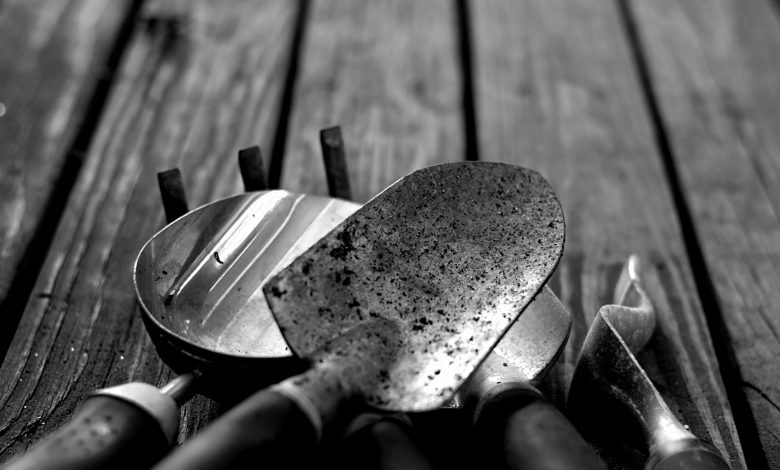How to Clean Gardening Tools

Cleaning gardening tools is beneficial at all points of the gardening season. As spring and summer roll in, gardeners should do an inventory of their tools and give them a good scrub in warm, soapy water to remove the remnants of that past season and winter build-up. After the gardening season is over, tools may be left dirty, dull, and even rusty. This will prevent the next season’s plot, particularly if the tools have gone far enough to the wayside that they must be thrown away. A gardener is only as good as the way s/he raises the plants and treats the land — and a broken hoe isn’t loosening up anything. It is best to spend time throughout the year maintenancing and cleaning tools. This will save you money and time in the long run.
Part of tool maintenance is to keep tools sharp, which will be easier on the gardener and healthier for plants. Keeping tools clean helps with preventing dullness of blades, and will help them last longer.
Clean Tools After Use
Simply rinsing dirt from a spade or hoe will help keep diseases, fungi, insects, and weeds from spreading in your garden. For example, you remove a plant that has been lost to an infestation at its roots. In order to remove the spoiled plant, or attempt to aid it, tools may be involved. If a shovel is put away with the infested dirt and reused the next day, there is a risk that other plants in the garden will also become infested. When removing diseased parts of a plant, dip tools into a container of a rubbing alcohol and bleach mix (one part bleach to nine parts water) or keep a disinfectant handy. Between each cut of an infected limb, stem, etc, wipe or dip blades into the cleaning product to prevent disease.
Wash the types of tools that are used in soil, i.e. the spades, the garden forks, and hoes, with a forceful water hose. Soils with clay, or other cakey soils, will be harder to remove; use a bristle brush to remove the excess dirt. If tools have been used in areas with sap, such as saws, pruners, etc, paint thinner will remove the sap. This step should be done after the initial rinsing.
After cleaning tools, remove water with a rag to prevent rust.
For tools that are not used in soil or in sticky places, such as axes and knives, wipe them down with a thick, rough cotton cloth. This will help remove any gumming or sap caught on blades. Paint thinner, again, will be helpful to remove residue in the event that the towel is not strong enough. If this happens, remember to go back, rinse off the tool, and dry with a towel to prevent rust.

Handling Wood Handles
When cleaning tools with wooden handles, finishing with moisture will help keep handles from drying out and turning brittle. Oiling up handles indoors is good practice, as the oil will seep into the wood better at room temperature. Some gardeners lean toward flaxseed or tung oil, as these substances dry quickly. Coconut and walnut oils work for this job, too.
To begin, saturate a cloth with the oil and rub down the tools. Let the tool sit for about ten minutes, then wipe down with a new, dry rag. Sometimes, this process may need to be repeated several times depending on the state of the wood. Handles will dry out faster if they are left out in the sun for extended periods of time. Wiping the metal pieces of the tool is also beneficial. The oil will help prevent rust build-up and move any crusted-on dirt.
Handle maintenance will help your tools last longer, which will, in turn, save money over time. Also, handles that are well taken care of will prevent blistering on your hands. A good time to do this process is whenever you have the time, but at least once a year. Careful, though, not to wait to start until handles begin cracking.
Remove Rust
Sometimes, removing water will not be enough to prevent rust, particularly if a tool is made of high-grade steel. Motor oil can also be used to help prevent rust. Wipe or spray tools lightly with the motor oil, or dilute it with a little bit of kerosene. There are several ways to apply the moisturizer to the tools. You can wipe down the tool with a saturated rag, dunk the tool, or spray it down with a spray bottle. Another way to keep away from rust is to mix soil and sand to keep the tools after each use. This method is cheap and easy, but will also prevent rust and keep soil from caking onto the tool. Before the season begins, perhaps early in spring, is a good time to sand down tools. This is because of wet, winter conditions that could corrode blades.
Some gardeners prefer to use tea or even sandpaper for serious rusting. For the first method, brew enough black tea to soak all tools with rust on them. After a few hours, remove the tools and wipe down with a cloth. Rust should wipe away easily. Afterward, rub the metal down with some wax paper. This will clean light dirt and rust from the tools, but also leave a protective wax coat. Sandpaper and wire-bristle brushes will tear away rust on tools with ease. However, be sure to oil your tools down after such harsh treatment. This will keep tools in good condition.

Organic Methods to Rust
Gardening can, at times, be heavily influenced by chemicals. However, it doesn’t always need to be that way. Though we just described methods to clean tools that do not involve chemicals, there are other methods that are used in the organic gardening community. To begin cleaning your tools, grab a putty knife and a wire brush. Scrape off dirt with the putty knife, going back over it with the wire brush to ensure all hard-to-reach spots have been cleaned. Then, again, hose down the tool.
If there is rust on the tools, soak blades overnight in a strong vinegar bath. This is safer for human and environmental health than kerosene and oil. In the morning, grab some steel wool and begin removing rust. Find your flaxseed, or other plant-based, oil and wipe down the metal to prevent rust. If the rust is more significant than a day’s work, it’s time to go bigger.
For up to two weeks, soak your tools in a tub filled with one part molasses to every nine parts water.
Sharpen Tools
Though sharpening tools is a bit more complicated than removing rust, its components are not very complicated. Any and all gardeners should be able to sharpen tools for optimal use. For the best results, you will need a hand file and honing stone. All of these can be found at hardware stores at an inexpensive price. Axes, shovels, hoes and trowels are easiest to sharpen using the hand file, while shears and knives are best sharpened with a honing stone.
The bastard-cut mill file (hand-held file) should be worked in one direction over the edge you are sharpening. Be sure the cutting teeth of the file are angled in the direction that you are moving the file. You may want to use a clamp or other brace to hold your tool down during this process. When using the honing stone, simply slide the blade across the stone in one direction until the tools are sharp. Be sure you are using the flat end of the stone.
You may be wondering how you know when a tool is sharp enough. The recommended angle of the beveled edge is between 10 and 45 degrees, depending on the tool. Blades that are sharpened at small angles will have wider bevel angles. The angle of sharpness determines the length of the bevel.
Knives and pruning shears will need finer edges in order to properly cut in the garden. These tools will see an angle of about a 10 to 25 degrees. Shovels, hoes, and mattocks — i.e. tools used for more intense chores — will dull more quickly then their counterparts. An angle of about 30 to 35 degrees is appropriate for these tools, and the bevel edge is far shorter than knives and shears.
There may be times when a grinder is needed, or perhaps the gardener prefers to use a mechanized process. Be careful, however, as grinders are heavy-duty sharpeners and will remove metal very quick. It may be better to use grinders in the most dire and dull of cases. Grinding wheels can also be found at hardware stores.
Sources
Barbara Pleasant (2018). “How to Clean and Oil Wood-Handled Garden Tools” GrowVeg
Brian Patrick Flynn. “How to Clean and Care for Your Garden Tools in 8 Easy Steps” HGTV
Leonard Perry. “Cleaning Gardening Tools.” University of Vermont Extension Department of Plant and Soil Science
Ken Textor. “Clean, Sharp Tools Work Better” Fine Gardening
Luddene Perry (2017). “How to Clean and Repair Garden Tools” Heirloom Gardener



